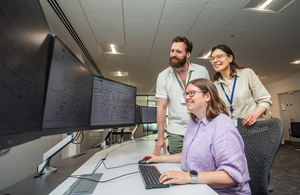Digital suite provides foundation for Tritium Fuel Cycle training
World-first Tritium Fuel Cycle virtual control room installed at UKAEA’s Culham Campus to train engineers in the handling and management of tritium

Operators using the Virtual Control Room - Image Credit: United Kingdom Atomic Energy Authority
- World-first Tritium Fuel Cycle virtual control room installed at UKAEA’s Culham Campus
- Facility designed and delivered by Bilfinger UK, representing significant investment in UK supply chain
- Simulations will be used to train engineers in the handling and management of tritium
- Virtual control room extends UKAEA’s extensive use of digital training platforms
- Capabilities for testing fuel cycles developed by third party companies and organisations
The UK Atomic Energy Authority’s (UKAEA) reputation as a world leader in the use of digital platforms for training, research and development purposes is extending into the tritium fuel cycle technologies which will be critical in delivering sustainable fusion energy in the future.
Developed in conjunction with Bilfinger UK, UKAEA’s new and unique virtual simulator will provide operators of the UKAEA-Eni H3AT Tritium Loop Facility with the opportunity to undergo simulated training exercises in a safe and controlled environment.
The digital system will also allow UKAEA to simulate potential changes to H3AT’s operating parameters and possible knock-on effects, increasing optimisation and efficiencies of processes.
Furthermore, alongside the ability to demonstrate H3AT’s capabilities to visiting stakeholders, the virtual control room could be made available in the future for third parties to test their own fuel cycle management systems.
Stephen Wheeler, Executive Director for Fusion Technology and Tritium Fuel Cycle, at UKAEA, said:
The UKAEA-Eni H3AT Tritium Loop Facility will be the largest and most advanced tritium fuel cycle in the world. It also represents a significant advance in the enhancement of industry capability within the fusion sector. By creating this digital control room with the support of Bilfinger, we’re increasing technical capability and supporting industry to deliver the mechanisms that will serve fusion in the future. The development will provide an unprecedented opportunity to train the next generation of fusion engineers through cutting-edge virtual simulation technology.
Using digital technology to train operators is business-as-usual across several divisions at UKAEA, so it is really pleasing that we are able to employ the same principles within the UKAEA-Eni H3AT Tritium Loop Facility.
We are also delighted to have been able to support a broad supply chain through this investment.
Bilfinger UK has experience in delivering marquee projects across multiple sectors. In addition to providing the control system, as a Tier One contractor Bilfinger UK facilitated and co-ordinated the sub-contracting process, including to Schneider Electric, AVEVA and Siemens.
Darren Clement, Vice President EAP, Bilfinger Engineering and Maintenance UK, said:
The exciting research at Culham has the potential to dramatically change the world’s future energy mix – realising the potential for safe, clean and virtually limitless energy. This virtual control room will give UKAEA the ability to further improve its processes while also ensuring staff are able to learn the important skills needed to help make sure operations run smoothly and safely.
At the same time, it can also help give important stakeholders a valuable insight into the ground-breaking work taking place in Culham. We’ve supported the nuclear industry for 60 years, supporting pioneers and major operators as they safely deliver clean energy in abundance.
UKAEA has a proven track record in using digital platforms to increase efficiencies of time and cost during staff training and the development of new technologies and processes.
The Remote Operations team at the Joint European Torus (JET) has been using such platforms for over 25 years, and they will now be applied to support the decommissioning of the fusion machine. Additionally, a full digital rehearsal of fuel debris retrieval at Fukushima Daiichi was conducted using the Next Generation Digital Mock-Up (NG-DMU), developed under the LongOps project, working with the Nuclear Decommissioning Authority, UK Research and Innovation, and the Tokyo Electric Power Company.